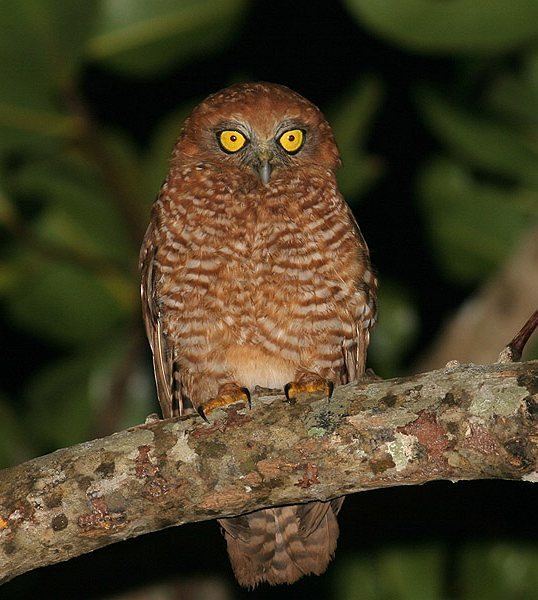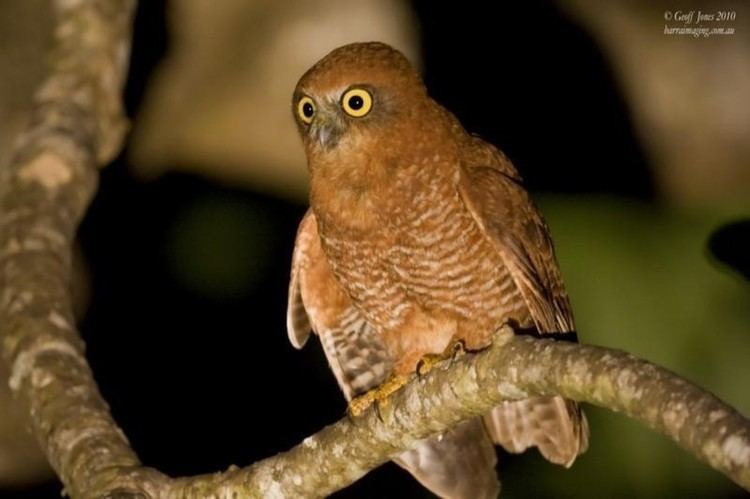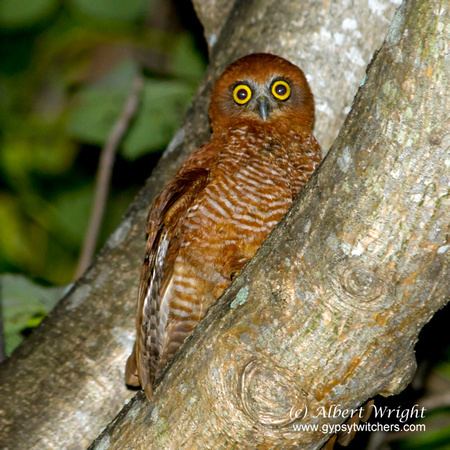Order Strigiformes | Phylum Chordata Family Strigidae Scientific name Ninox natalis Rank Species | |
 | ||
Similar Owl, Ninox, Solomons boobook, Bird, New Britain boobook | ||
The Christmas boobook (Ninox natalis), also known more specifically as the Christmas Island hawk-owl, is a species of owl in the family Strigidae.
Contents

Closely related to the hawk owls of Southeast Asia and Australia. N. natalis was first classified at species level by J.J.Lister in 1888. It was not until 1998 however that DNA testing confirmed its status as a separate species from other owls.

Distribution

N. natalis is endemic to Christmas Island, a small Australian territory of about 135 square km situated in the Indian Ocean approximately 360 km south of Java.

The flora and fauna of the island face on-going threats from both human activity and introduced species of plants and animals. As in addition N. natalis is restricted to a small range on this small island it is listed as vulnerable by the I.U.C.N.

Phosphate mining has continued for over a century and more recently Australian Immigration Detention Facilities have been established increasing the impact from human habitation. However, the Australian National Parks and Wildlife Service now manage 64% of the island as a national park.
Description
The Christmas Island Hawk Owl is a small, rufous-brown hawk-owl with a barred breast, dark chestnut facial mask, whitish brow, lores and throat, yellow eyes, legs and feet. It is approximately 26–29 cm in length and 130-190 grams in weight with the female slightly larger than the male.
The double-noted hoot, boo-book, has a clucking quality with the second note usually lower in pitch. The begging call of juveniles is a high-pitched trill.
Vocalisations are similar to those described for the Southern Boobook N. novaeseelandiae and include individual variation in advertisement calls. This may be useful in estimating owl densities as radio-tracking can be impractical in some terrains.
A recording, courtesy of Richard Hill and Owl Pages http://www.owlpages.com/sounds/Ninox-natalis-2.mp3
Habitat
Its natural habitats are subtropical or tropical moist lowland forests and subtropical or tropical moist shrubland.
N.natalis occupies essentially exclusive territories and is widespread on the island utilizing both primary and disturbed habitats. However, in areas of regrowth significantly fewer birds have been detected. In 1995 there were approximately 560 breeding pairs but by 2004 the population was estimated to be down to 1000 birds. A more recent estimate in 2011 suggests the population may however be significantly lower than that.
Preferred roost sites are sheltered and concealed, positions from which they can easily escape such as in the bottom third of the canopy of trees with deep crowns and mid-level under-story but with fewer low under-story trees.
Nests have been found in tree hollows predominantly in the canopies of Planchonella nitida, Hernandia ovigera and Syzgium nervosum.
Diet
Primarily insectivorous they consume medium to large insects, particularly beetles (Coleoptera), tree crickets Gryllacris rufovaria, moths (Lepidoptera) and introduced cockroaches Periplaneta americana. They also supplement this with vertebrates such the Christmas Island White-eye Zosterops natalis, geckos including the introduced House Geckos Hemidactylus frenatus, and the introduced Black Rat (Rattus rattus).
Threats
Man-made habitat destruction together with the introduction of species such as the Yellow Crazy Ant Anoplolepis gracillipes, cats Felis catus and black rats are among the major threats to both the habitat and native wildlife including the Christmas Island Hawk-Owl.
Yellow Crazy Ants disrupt the habitat in a number of ways but most notably through their elimination of populations of the island’s key-stone species, the red crab Gecarcoidea natalis resulting in significant changes to forest composition. In addition, the ants mutually-beneficial relationship with scale insects has contributed to degradation of the canopy.
It is thought Yellow Crazy Ants may also prey on nestlings.
While mining has largely ended various programmes to monitor and control introduced species are on-going.
